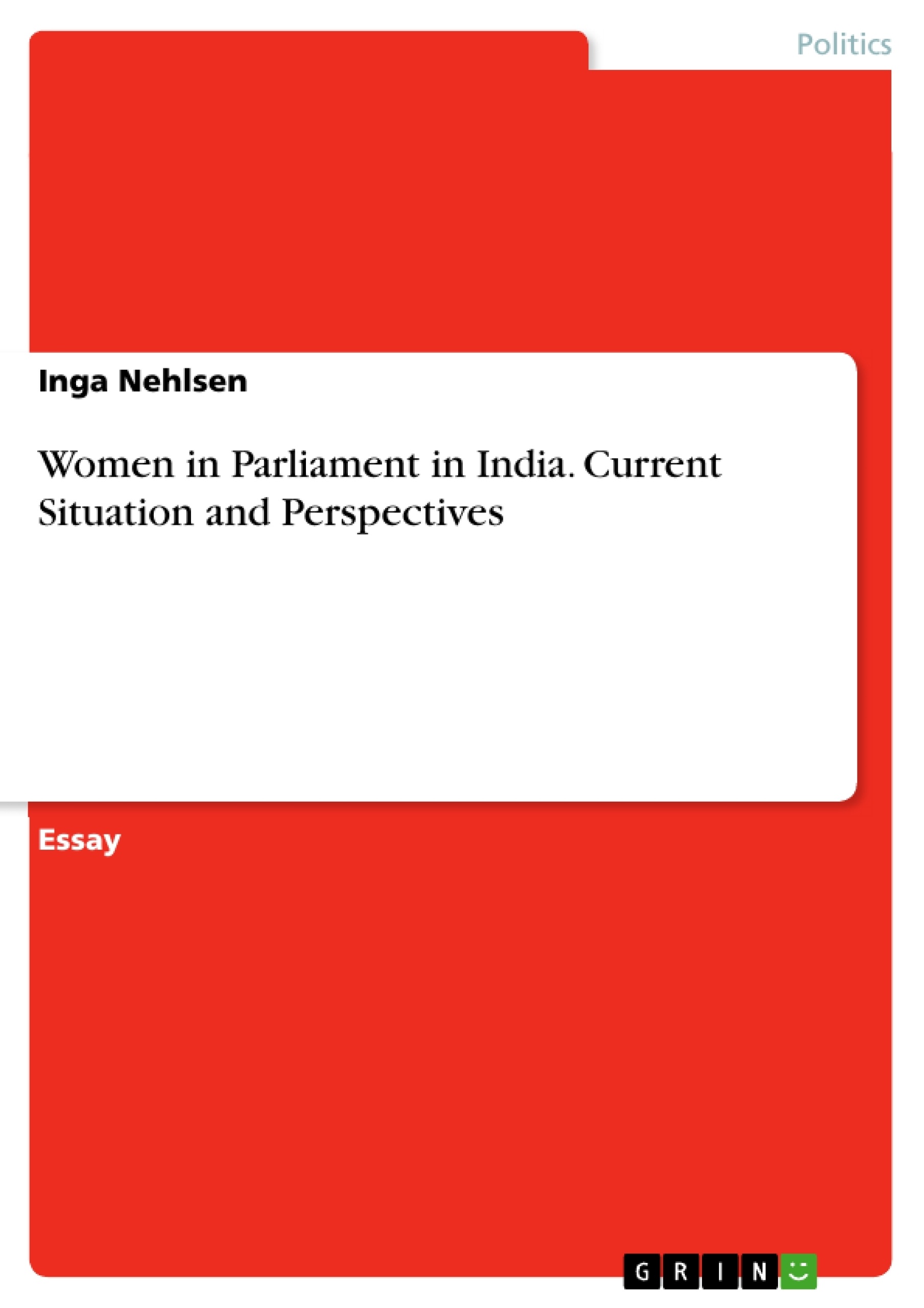India is a constitutional democracy with a bicameral parliament that consist of an Upper House (Council of States or Rajya Sabha) and a Lower House, while the Lower House is more powerful and thus more important for the purpose of this paper.
It consists of 545 members, who, with the exception of two members who are appointed by the president are elected by popular vote. This paper deals with the situation of women in parliament, i.e. in the Lower House. Therefore the words “parliament” and “Lower House” will be used as synonyms for the purpose of the paper.
Introduction - Basic Information
India is a constitutional democracy with a bicameral parliament that consist of an Upper House (Council of States or Rajya Sabha) and a Lower House (People's Assembly or Lok Sabha) (Central Intelligence Agency, 2011), while the Lower House is more powerful and thus more important for the purpose of this paper (Gill, 1998). It consists of 545 members, who, with the exception of two members who are appointed by the president are elected by popular vote (Central Intelligence Agency, 2011). This paper deals with the situation of women in parliament, i.e. in the Lower House. Therefore the words “parliament” and “Lower House” will be used as synonyms for the purpose of the paper.
The Situation of Women in the Indian Parliament
There has been an increase in the percentage of women in the Indian Parliament within the past 15 years. According to the Inter-Parliamentary Union (IPU) (2011) in the elections of April 1996 only 39 out of 545 seats (7.2 %) were occupied by women. The next elections in February 1998 and then in September 1999 resulted in a percentage of 8.1 % and 8.8 % respectively. Five years later, in April 2004 already 49 women were elected into the Lower House, with a total of only 541 seats this time they made up for 9.1 %. In the last elections in 2009 10.8% (59 out of 545) of the parliament were women. (Inter-Parliamentary Union, 2011) However, this number is still quite far below the international average of 2009, 18.3 % (Wängnerud, 2009, p. 52). Out of 137 ranks on the IPU website, India in 2009 still only ranked 99 (Inter-Parliamentary Union, 2011).
Reasons
What are reasons for this comparatively low percentage of women in the Indian parliament, but also for the increase during the past 15 years?
According to Wängnerud (2009), percentages of women in parliament are lower in countries with majority systems than in those with a proportional representation (PR) system, because the latter is not as competitive, while in a majority system “a woman has to be the number-one choice for her party in order to take part in the race” (Wängnerud, 2009, p. 54). Since the majority of the members of the Lower House in India are elected directly within a First Past the Post system (FPTP) (Rangarajan & Patidar, 1997), this is a very competitive political environment, especially for women. Furthermore India’s society in general is a rather patriarchal one, making it more difficult for women to get involved in politics in the first place (Rai, 2002, p. 5).
Another reason could be found in the composition of India’s party system. Wängnerud argues that more left-oriented parties, with liberal attitudes regarding social policies tend to have higher percentages of women elected than others (Wängnerud, 2009, p. 55). In the past 15 years the CPM[1], which fulfils most of these criteria, did not form part of any of the governments. They have been led by either rather centralist parties (the United Front coalition in 1996 and the Congress Party in 2004 and 2009) or, in 1998 and 1999, by the more right-oriented Bharatiya Janata Party (BJP) (Inter-Parliamentary Union, 1996-2008 and BBC News Website, 2009).
Moreover, the CPM has a strong women’s organization themselves, the All India Democratic Women’s Association (AIDWA), as well as active relationships with independent women’s movements, which according to Wängnerud (2009) can be an important point of access for women to politics (Wängnerud, 2009, p. 55). Although the BJP has strong connections to non-political organizations as well, the communist parties in general collaborate much more actively with the independent women’s movements (Basu, 2005, p. 23-24 and p. 34).
Despite the fact that the current percentage of women in the Indian parliament is below average, there has been an increase during the past 15 years and even before that women already owned a small percentage of the parliament (Inter-Parliamentary Union, 2011). A basis for this might have been laid with the 73rd and 74th Amendments to the Constitution in 1993, which ensure women at least one third of the seats in the “local self-governing bodies (panchayats and municipalities)” (Raman, 2002, p. 1).
[...]
[1] The ‘Communist Party of India (Marxist)’ developed out of the Communist Party of India (CPI) but is in fact not a communist, but rather a social democratic party. They also pursue reform programs that match Wängnerud’s (2009) description of “parties that value environment over economic growth and are pro-permissive in social policy” (Wängnerud, 2009, p. 55), i.e. those with higher percentages of women elected. (Basu, 2005, p. 23 and Wängnerud, 2009, p. 55)
- Arbeit zitieren
- Inga Nehlsen (Autor:in), 2011, Women in Parliament in India. Current Situation and Perspectives, München, GRIN Verlag, https://www.grin.com/document/303447
-

-

-

-
Laden Sie Ihre eigenen Arbeiten hoch! Geld verdienen und iPhone X gewinnen. -

-
Laden Sie Ihre eigenen Arbeiten hoch! Geld verdienen und iPhone X gewinnen. -

-
Laden Sie Ihre eigenen Arbeiten hoch! Geld verdienen und iPhone X gewinnen. -

-
Laden Sie Ihre eigenen Arbeiten hoch! Geld verdienen und iPhone X gewinnen.

